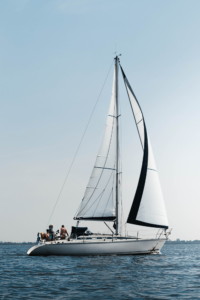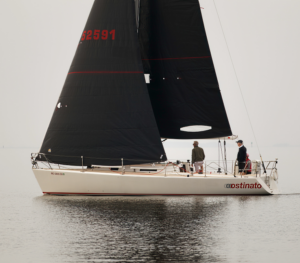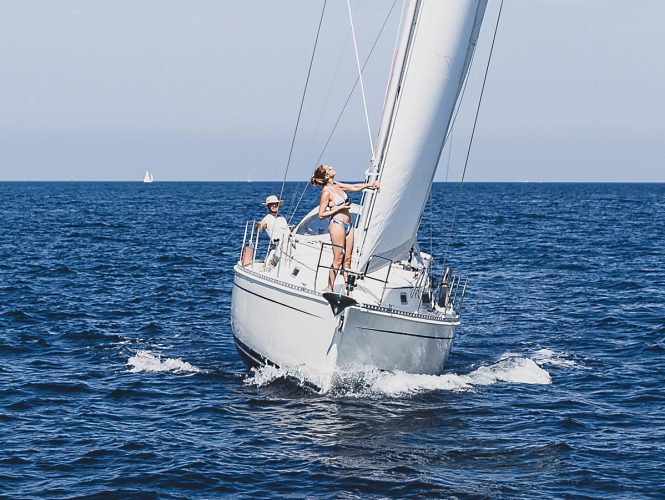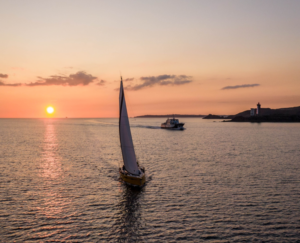You might think that all that talk about new high-tech sails and state-of-the-art sail-making techniques is a conversation that belongs exclusively to performance sailors and wealthy yachtsmen, but that is not at all the case. Leading sailmakers such as North Sails, Doyle Sails, and Quantum Sails understands that there is a huge market in cruising sails, and therefore put equal effort into developing top-of-the-range sails to suit each cruiser and their boat.
In this article, we will be taking a look at some of these new sails available on the market as well as discuss what to look out for when shopping for cruising sails, and what to consider in order to make the right decision to ensure your ultimate cruising performance.
 Sailcloth
Sailcloth
A part of choosing new cruising sails is choosing the right sailcloth to suit your specific boat and sailing needs and to do this right, it is important to first understand a bit about the different sail materials.
There are essentially three options: conventional woven sails, generally made from Dacron (polyester), laminate and membrane sails, and 3D molded sails. A few qualities really set these apart, and it is matching these qualities to your own boat and needs that will ensure that you end up with the right headsail.
When it comes to performance, the cruiser generally has different preferences to the racer, and where the racer would be putting speed before all else, the cruiser will be looking more at qualities such as easy sail handling, managing heel and weather helm, affordability and longevity.
What To Consider
Budget
When it comes to sailcloth there is a wide range in price, and to narrow the search it is a good idea to consider your budget first. If you are looking to purchase a top-of-the-range sail using the newest technology, you can expect to pay a lot. The most affordable sails are the woven Dacrons, so if you are on a small budget, this might be a good place to start.
Longevity
For a cruiser especially, longevity is a very important factor when choosing new sails, and it is important to consider that the most expensive top-of-the-range sail, is not necessarily the sail that will last the longest. On the contrary, it is the more affordable Dacron sails, that are known to be the longest-lasting.
 Shape Retention
Shape Retention
Woven Dacron sails might be a winner when it comes to affordability and longevity, however, one downside to this woven Dacron is the fact that they have poorer shape retention compared to other sail constructions. This is due to the weave (the crimp) of the cloth stretching, and over time, woven sails will lose their shape and become baggy. Since composite sails are unwoven, there is no crimp, and the result is a sail that can resist stretch as much as 500 percent more than the traditional woven sail.
Weight
Although this usually is more of a concern to racers, weight does play a role in overall sail performance, especially in regard to bigger boats and boats sailing in very light weather. Dacron sails are generally quite heavy in comparison to other sails, and this can be an issue on bigger boats and performance boats.
Application
Finally, it is important to consider what type of sailing you do and what conditions you will meet on the way. Figuring out your priorities, whether it is having a high-performance sail or a sail that will last for your voyage around the world, will greatly help you purchase the right type of sails.
Paneled Sails
Woven fabrics, usually made from polyester (Dacron) are still to this day the most common construction for sailcloth and are widely used in all sailing applications. This is mainly due to its durable qualities and the fact that it is the most affordable option. However, a downside to woven sailcloth is its elasticity, caused by the crimp, (the over-and-under nature of the weave) and over time the sail will inevitably lose shape and start sagging.
For a cruising sailor, especially of smaller-sized boats, who values longevity and affordability over all else, the conventional woven Dacron sails might still be the best option.
North Sails’ NPC
North Sails offer two options for woven Dacron cruising headsails: The NPC Cross-Cut, using fill-oriented cross-cut sailcloth, and the enhanced NPC Radian using Radian Warp-oriented sailcloth.
It is the most affordable sail type offered by North Sails, and on top of that, this sail type provides excellent durability and maximal longevity. However, it is not the best sail when it comes to shape-retention and weight and is therefore mainly recommended for small to mid-sized boats.
Doyle Dacron
Doyle Sails also offer two options in the paneled woven Dacron category: The Cruise Dacron, a cross-cut sail developed to suit the cruising sailor who prioritizes durability, value for money, and long service, and the Performance Cruise Dacron, an enhanced version of the aforementioned, using larger patch sizing and heavier duty hardware.
These sails are available in 5 different sailcloth: Dacron, Dacron Hybrid, Hydranet, Crosscut, and Radial.
Quantum Sails’ CW 2000
Quantum’s CW 2000 woven polyester mainsails and headsails are made using cross-cut construction featuring panels joined with extra wide seams, using a combination of adhesives and multiple rows of triple-throw stitching, with additional “butterfly” reinforcements at both the inboard and outboard ends.
The CW 2000 also comes with many optional features such as full battens, telltale windows, and clew fittings to fit furling mainsails.
Quantum recommends this sail construction for cruising boats less than 50 ft.
Composite Sails
Laminate and membrane sails are a modern-day art and have in the last few decades become very popular, especially with the racing crowd. But cruisers are also beginning to open their eyes to the great values of these high-performance sails, esteeming this constitution’s great advantages such as high durability and exceptional shape retention.
When building laminate sails, various materials and building techniques can be used, but generally speaking, laminate sails are a sandwich construction, laminating fibers or scrim protected with mylar film between one or two taffeta layers. The core fibers can be of various materials, such as polyester, aramid, or carbon, having different effects on the overall strength and weight of the finished cloth. There is no doubt that, when it comes to both durability and shape retention, laminates by far surpass woven materials.
The difference between laminates and membrane sails is in the construction method: Whereas laminates are made from rolls of prefabricated laminate sailcloth, membrane sails are made ‘from scratch’, putting together the fibers to make the fabric at the same time as building the sail. This building method permits the sailmaker to be specific in fiber density across the sail, to match the expected loads put on the sail when in use. These fully custom-made sails are a step up from laminates when it comes to both strength, shape retention, and price.
North Sails’ NPL Tour and Ultra Tour
North Sails’ Xi Cruise styles are built using polyester woven outer plies surrounding polyester film and high modulus aramid fiber on the inside. These sails demonstrate remarkable toughness and environmental resilience. Although NPL sails do not have the same expected lifespan as woven Dacron, they far outperform Dacron when it comes to shape-retention and they are expected to only change slightly over time.
The Xi Cruise sails are aimed at mid-size cruising boats and are of medium price.
A step up from the Xi Cruise, the Ultra X’ are aimed at mid-sized to super-sized cruising boats. The key difference between the Xi Cruise and the Ultra X is the use of UltraPE fiber used in Ultra X, granting it superior shape-retention. The price of Ultra X is a little higher than Xi Cruise.
Doyle’s Stratis Series
The laminate Stratis sails are custom-made in New Zealand and engineered with different fibers from polyester to carbon fiber to suit every boat and sailing application. On top of that, the outside surface is picked with the client, ensuring that you get the most desirable finish.
The Stratis series include STRATIS 500, STRATIS 800, STRATIS 1100 CT and STRATIS 1100CI.
Quantum Sails’ Fusion M Sails
Using the most advanced membrane construction, Quantum’s Fusion M Sails guarantees unprecedented shape for maximum control. Designing a sail that is easy to trim and very versatile with many optional features to provide the best tailor-made sail for you and your specific sailing application.
With a wide selection of fiber and filament packages, as well as options for the latest skins, Quantum Sails can provide you with a sail designed to meet your specific needs.
All Fusion M sails are available in square-top or pin-head options and a choice of gray or white taffeta protective skins.
 3D Molded Sails
3D Molded Sails
3Di sails, a trademark construction exclusively developed by sailmaker North Sails, is a relatively new technology, but one which has found its place at the very top of the range when comparing high-performance sails. Unlike paneled sails which are built on a flat surface, 3Di sails are built, much like a hull or an airplane wing, using a 3D mold. But, just like traditional sailcloth, 3Di sails are made using fibers or filaments (70% of the sail structure), and resin (30% of the sail structure).
The filaments used in constructing 3Di sails can be of various materials enhancing different qualities to suit different sailing applications. But the art is in the construction, and it is the way that North Sails uses the different materials that sets them apart from other sail constructions.
A huge advantage of 3Di sails is that it does not require the use of mylar film, making the 3Di sail superior to laminates in weight and longevity as there is no concern for delamination. But, as you would expect, this top-of-the-range sailcloth technology comes at a top-of-the-range price, not viable for the budget sailor.
North Sails’ 3Di Ocean
When it comes to 3Di cruising sails, North Sails’ offers 3 different options: The 3Di Ocean 330, 370, and 700, with the 330 meant for small to medium-sized boats and 700 meant for large-sized boats. The key differences are in the use of Ultra PE in the Ocean 370 and 700 significantly boosting strength and improving its shape-retention at the same time as reducing weight, making these sails viable for large-sized boats.
The main advantage of this unique sail construction is superior shape-holding in lighter-weight sails without compromising durability.
The price of 3Di sails is significantly higher than Dacron sails, but for performance cruisers, especially of bigger boats, this sail construction is definitely worth considering.
Get A New Cruising Sail Quote
While there are many


